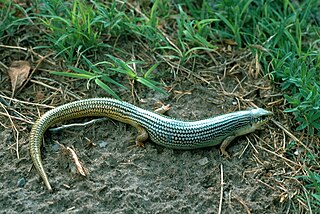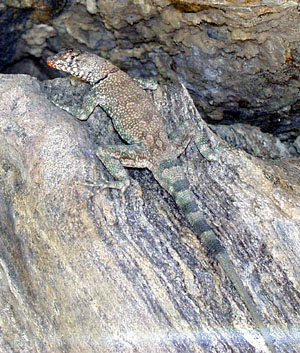
The eastern copperhead, also known simply as the copperhead, is a species of venomous snake, a pit viper, endemic to eastern North America; it is a member of the subfamily Crotalinae in the family Viperidae.

Gerrhonotus is a genus of anguid lizards that are commonly referred to as alligator lizards, due to a vague resemblance to an alligator. Most species are restricted to Mexico, but a few range into Guatemala or Texas, and G. rhombifer is from Costa Rica and Panama. Along with glass lizards (Ophisaurus) and many other lizards, alligator lizards have the ability to regrow their tail.

The southern alligator lizard is a common species of lizard in the family Anguidae. The species is native to the Pacific coast of North America. It ranges from Baja California to the state of Washington and lives in a variety of habitats including grasslands, chaparral, forests, and even urban areas. In dry climates, it is likely to be found in moist areas or near streams. There are five recognized subspecies.

The Great Plains skink is a species of lizard endemic to North America.

The prairie skink is a species of skink endemic to the prairies east of the Rocky Mountains in North America. It is one of only seven species of lizards that occur in Canada.

The northern alligator lizard is a species of medium-sized lizard in the family Anguidae. The species is endemic to the North American west coast.

The granite spiny lizard is a species of lizard in the family Phrynosomatidae.

Petrosaurus mearnsi, also called the banded rock lizard, is a species of lizard in the family Phrynosomatidae. The species is native to western North America.

Crotaphytus reticulatus, commonly called the reticulate collared lizard, is a species of moderately sized lizard in the family Crotaphytidae. The species is native to semiarid, rocky regions of the Tamaulipan mezquital. Its range includes the US state of Texas and the Mexican states of Coahuila, Nuevo León, and Tamaulipas. Of all the species in the family Crotaphytidae, C. reticulatus is the only species which is not restricted to rocky habitats.

Ctenosaura pectinata is a species of moderately large lizard in the family Iguanidae. The species is native to western Mexico.

Holbrookia maculata, commonly known as the lesser earless lizard, is a species of lizard in the family Phrynosomatidae. The species is native to the southwestern and central United States and northern Mexico. There are eight recognized subspecies.

Sceloporus merriami, commonly known as the canyon lizard, is a species of lizard in the family Phrynosomatidae. The species is native to the south-western United States and northern Mexico.

Arizona elegans philipi, commonly known as the Painted Desert glossy snake, is a subspecies of glossy snakes, a nonvenomous colubrid endemic to North America.

The Mexican alligator lizard, also known as the green arboreal alligator lizard, is an endangered species of lizard endemic to the Sierra Madre de Oaxaca highlands of Mexico. It can be found in the states of Puebla, Veracruz, and Oaxaca. It was originally described under the genus Gerrhonotus as Gerrhonotus gramineus by Edward D. Cope in 1864.

Agkistrodon contortrix mokasen was formerly a venomous pit viper subspecies found in the eastern United States. However, recent taxonomic changes do not recognize the northern copperhead as a valid taxon.

The long-nosed leopard lizard is a species of relatively large North American lizard in the family Crotaphytidae. Gambelia wislizenii ranges in snout-to-vent length (SVL) from 8.3 to 14.6 cm. It has a large head, a long nose, and a long round tail that can be longer than its body. It is closely related to the blunt-nosed leopard lizard, which closely resembles the long-nosed leopard lizard in body proportions, but has a conspicuously blunt snout. The species G. wislizenii, once considered part of the genus Crotaphytus, is under moderate pressure because of habitat destruction but is categorized as "least concern".

The eastern glass lizard is a species of legless lizard in the family Anguidae, endemic to the Southeastern United States. The streamlined, legless species is often confused with snakes. Glass lizards differ from snakes as they possess a moveable eyelid and an external ear opening, both of which are absent in snakes. Ventralis comes from the Latin "venter" meaning belly; this is in reference to the snake-like movement.
The isthmian alligator lizard is a species of lizard of the Anguidae family. G. rhombifer is found in both Costa Rica and Panama. Unlike many lizards near its habitat, individuals have lateral folds. They give birth to live young. Gerrhonotus rhombifer had not been seen for fifty years, prior to being rediscovered in 2000 near Golfito, and is one of the rarest species of lizard in Costa Rica.

The Madrean alligator lizard is a species of lizard in the family Anguidae. The species is endemic to the southwestern United States and adjacent northwestern Mexico.

Gerrhonotus liocephalus, the Texas alligator lizard or Wiegmann's alligator lizard, is a species of lizard of the Anguidae family. It is found in Texas, Mexico and Guatemala.





















